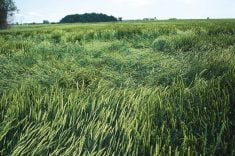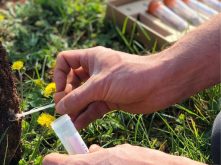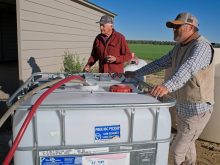Corn is a crop that needs a lot of nitrogen to grow properly and produce the best yields. With today’s high prices for fertilizer and high crop prices, it’s more important than ever to strike the right balance that optimizes yields and profits while keeping fertility costs under control.
“There’s a lot of money at stake,” says John Heard, a soil fertility extension specialist with Manitoba Agriculture. For corn producers, the risks are spending too much on expensive fertilizer on one hand and not buying enough fertilizer to really cash in on high crop prices on the other.
“There can be a large opportunity cost if under-fertilizing is undertaken,” Heard says. He notes in addition to economic and agronomic considerations, another key concern for farmers making nutrient management plans is reducing nitrous oxide and other emissions from fertilizer use — a key plank in Ottawa’s 2030 Emissions Reduction Plan released in March.
Read Also

Cancer agency reclassifies another herbicide ‘probably carcinogenic’
The WHO’s cancer research agency has now put atrazine, a herbicide well known to corn growers, in the same potential-hazard category where the agency put glyphosate.
To help corn producers get the most out of their fertilizer dollars, Heard offered up some tips in a recent interview with Grainews.
While corn has a large appetite for nitrogen, the good news for farmers is it’s much easier to address fertility problems in-season than it is for other Prairie crops like wheat and canola.
“It shows visual symptoms when nutrients are lacking probably better than most of our other crops. It shows us when it hurts,” says Heard. “Since corn has such a long lifespan, there’s lots of time to intervene. You can apply fertilizer like nitrogen from the previous fall right through until the crop is waist high.”
Heard says in Manitoba the optimum rates generally fall between 150 and 190 pounds of nitrogen per acre across a range of environments. He adds research work he has done with others has shown if you can get within 15 to 20 pounds of the optimal rate, the economic return in terms of yield is essentially the same.
Heard maintains soil testing is an excellent tool, not only for dialing into nitrogen rates but also as a way to audit fertility programs to ensure crop needs are being met.
He says a rule of thumb from University of Manitoba studies is if soil testing after a corn crop shows there are 20 to 50 pounds per acre of residual nitrogen, you’ve done well in applying enough nitrogen to meet the yield potential of the crop.
If tests indicate there are less than 20 pounds per acre left, the crop was undersupplied and likely fell short of its yield potential. If the tests show there are more than 50 pounds per acre left, then more nitrogen may have been applied than was needed to meet the crop’s yield potential.
As Heard points out, higher nitrogen levels can also be caused by drought, such as the case last year throughout much of the Prairies, where extremely dry conditions resulted in high to very high soil residual nitrogen levels in many fields.
“We’re all hoping that’s something farmers can exploit with this year’s crops,” Heard says. He maintains high corn prices and good residual soil nitrogen levels should keep corn a profitable component of a farmer’s rotation.
Heard also believes Manitoba farmers will likely reduce nitrogen rates for corn in 2022, primarily because of high residual levels and high nitrogen costs.
“However, higher fertilizer prices do mean that growers have more risk in order to pursue high potential returns. Good field husbandry is always important, especially early weed control, to optimize nitrogen use efficiency,” he says.
Banding better than broadcasting
When it comes to nitrogen placement for corn in Manitoba, Heard says subsurface banding generally works better than broadcast applications.
“Fall banding or spring pre-plant banding is preferred, but in-crop there are excellent opportunities to band nitrogen through injection or side dressing between the rows with anhydrous ammonia or liquid nitrogen. Those are very common in corn country,” he says.
Heard notes there are other options for corn producers, such as dribbling fertilizer on the soil surface, but they may come with a higher risk of nitrogen losses. In that case, he says, farmers may decide to make use of enhanced efficiency fertilizer products to reduce the risk.
Heard says Manitoba corn producers with farms on heavier soils tend to apply nitrogen in the fall, while many of those on sandier soils will apply nitrogen pre-plant or in-season to reduce the chances of nitrogen losses through leaching.
Split applications of nitrogen can be a good option for corn producers, he says. “Farmers I know who have some of the best nitrogen use efficiency are those that are doing some sort of banding at seeding or prior to seeding and then following up with in-season soil applications afterwards.”
However, there’s a danger in shorting a corn crop early, he warns. “We have seen the occasional yield penalty when people wait too long or withhold too much (nitrogen) at the beginning.”
Heard says a good rule of thumb for farmers opting to do split nitrogen applications is to apply around 20 to 30 per cent before or at seeding and the remaining 70 to 80 per cent in-season, as long as they start to side dress early when the crop is six inches tall. If farmers opt to delay the second application until the crop is waist high, then a 60/40 split is recommended.
Heard also cautions corn producers to make sure they spray their crops on time. He says studies in Wisconsin have shown delaying herbicide applications until the crop is four inches tall can mean an extra 30 to 50 pounds per acre of nitrogen is required to match corn yields produced by a crop that’s weed-free from the start.
“The longer you let the weeds grow, the greater the nitrogen penalty until, at some point, you can’t make up the yield even with higher nitrogen rates. The real message is to get those weeds sprayed or use a weed control program that controls the weeds early until you can get back in there with your second application,” says Heard.
Potassium and other key nutrients
Potassium is also essential for corn growth. Corn takes up a lot of it and the nutrient also boosts the efficiency of nitrogen fertilizer.

Heard says studies indicate the optimal potassium content in soil for most crops is about 100 parts per million, but for corn it has been shown to be 200 parts per million.
In Manitoba, clay or clay loam soils generally contain sufficient potassium for good corn growth, while sandy soils may not, Heard notes. In those instances, potassium application and placement are an important consideration for corn producers, he says.
“Banded potassium in corn is more effective than broadcast,” says Heard. “To achieve the same type of yield response that a banded application of potassium would give you, you would need to apply two times the rate as a broadcast application.”
The same applies to another key nutrient — phosphorus. Banded applications are also recommended, Heard says, and in Manitoba it’s typically carried out this way, either in the fall or during seeding time in the spring.
“It needs to be done before or while seed is being put in the ground because you don’t have the option to do in-season applications of phosphorus,” he says.
One thing farmers should be aware of is how growing corn after canola can lead to lower yields due to nutrient deficiencies of phosphorus and zinc, says Heard.
He explains that, in corn, symbiotic fungi or mycorrhizae are exploited by the plants to access phosphates and, to a lesser extent, zinc in the soil. The fungi go dormant with a canola crop, he says, and it can then take up to 50 days for the mycorrhizae spores to germinate and colonize the corn plant roots. Often, that’s too long to wait for the corn to start taking up phosphorus, and crop growth slows down as a result.
“Often, when we see … delayed crop maturity, the corn is wetter at harvest, it requires more drying, and there’s maybe a 10 per cent yield reduction,” says Heard.
“Studies were done here several years ago that found phosphorus placement banded close to the seed at a good rate is about the best you can do if you choose to grow corn after canola. But the easiest solution is to grow something else after canola.”
Heard points out sulphur deficiency is rarely a concern with growing corn after canola, but he says he has seen this occur with some Manitoba farmers who’ve displaced canola in their rotations with soybeans.
“Sulphur is usually liberally applied to canola, and the other crops in rotation do quite well on the residual amounts. But once canola disappears from rotation and the sulphur disappears, the other crops are likely to show some deficiency,” he says.
Heard says fortunately for farmers, sulphur deficiencies, like nitrogen deficiencies, can be remedied with supplemental in-season applications, as long as they’re properly diagnosed.
















